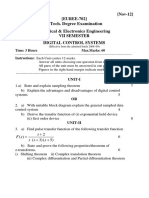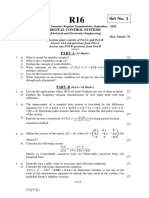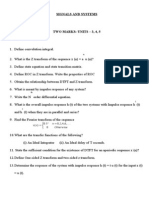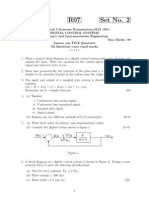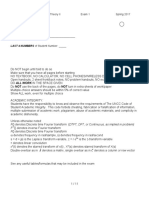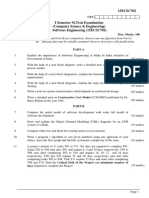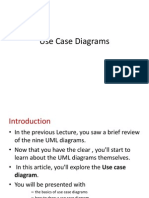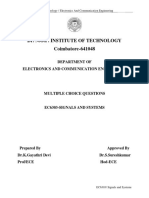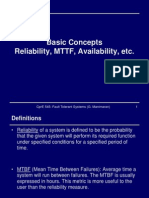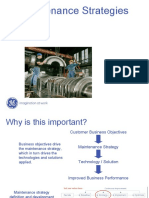Problem Sheet on Discrete-time System (EE 812)
1. Obtain the z-transform of (a)
t 2 e at , (b) te at , (c)
, (b) (
2. Obtain the z-transform of (a)
, (d)
, (d) (
, (c)
3. Obtain the z-transform of the following ( ) :
( )
Assume that ( )
for
4. Obtain the inverse z transform of X z 1 2 z 3z 4 z 5 z .
4
2
z
z 0.5 z 1
5. Obtain the inverse z transform of X z
by partial fraction
1 0.5z 1 1 0.8z 1 2
1
method.
6. Given
z 1
,
X z
1 z 1 1 1.3z 1 0.4 z 2
and final values of
xk .
7. Find the inverse z transform of
determine
xk ,
and obtain the initial
z 1 1 z 2 using direct division method
X z
1 z 2 2
(power series expansion).
(
8. Find the solution of the difference equation
where ( )
( )
and ( )
( )
( ),
. For the input function ( ), consider the
for
following two cases:
(i)
( )
(ii)
( )
and ( )
and ( )
9. Solve the difference equation (
and ( )
. The input function ( ) is given by ( )
10. Solve the difference equation using z transform:
where ( )
( )
and ( )
for
, (
), where ( )
.
( )
)
(
(
)
)
( ),
11. For the transfer function models and the input given below, find the output response
( ) as a function of
(a)
(b)
(c)
Y z
2z 3
, ( )
Rz z 0.5z 0.3
Y z
1
, ( )
G z
Rz z 0.5z 0.3
Y z
1
, ( )
G z
2
Rz z 0.5 z 0.1
G z
( )
( )
( )
�(d)
Gz
Y z
1
R z
z
2
6z 1
, ( )
1
1
1
j z j
4
2
4
12. Consider a transfer function
X s
s3
.
s 1s 2
( )
Obtain the pulse transfer
function by direct application of z transform.
( ) of this
13. Figure 1 shows a discrete-time system. Determine the transfer function
system assuming that the samplers operate synchronously at intervals of
sec. Also find
the unit-step response of the system.
()
()
()
ZOH
()
Figure 1
14. Obtain the closed-loop pulse transfer function of the system shown in Figure 2. Assume
. For a unit step input, determine the response ( ).
()
ZOH
()
()
Figure 2
15. Obtain the closed-loop pulse transfer function of the system shown in Figure 3. Find the
response ( ) for unit step input.
()
+
-
ZOH
=1
()
Figure 3
()
()
(
�16. Compare the stability properties for the system shown in Figure 2 assuming
with (i)
and
, (ii)
17. Repeat Problem 14 with
( )
and
sec.
( )
18. (a) A unity feedback system has the transfer function
Find the response ( ) of the system to a unit step input. (b) A sampler and ZOH
are now introduced in the forward path as shown in Figure 2. For a unit step
input, determine the output
( ) for first five sampling instants when (i)
, (ii)
( )
19. A unity feedback system has the transfer function
)(
(a) Using the
Routh stability criterion, show that the closed-loop system is stable. (b) A
sampler and ZOH are now introduced in the forward path as shown in Figure 2.
Show that the stable linear continuous-time system becomes unstable upon the
introduction of sampler and ZOH.
( )
20. Consider the system described by
(
( ) where
( ) is the input and
( ) is the output of the system.
Determine the stability of system using Jurys stability criterion.
21. The characteristic equation of a linear digital system is
Determine the values of
for which the system is stable.
22. Consider the system shown in Figure 2. Plot the root loci as the gain
to
. Determine the critical value of gain
is varied from
for stability. The sampling period
23. Consider the digital control system shown in Figure 4. Find the root loci as the gain
varied from
to
. Determine the critical value of gain
is
for stability. The sampling
period
() +
(
)(
()
Figure 4
24. Consider the system as shown in Figure 2 with
Draw a Bode diagram in the
becomes equal to
( )
plane. Set the gain
. With the gain
and
so that the phase margin
so set, determine the gain margin.
3
�25. Consider the system as shown in Figure 2 with
Draw a Bode diagram in the
( )
)(
and
plane.
26. Obtain the transfer function description for the following system:
[
(
(
)
]
)
( )
]
( )
][
* + ( ); ( )
( )
27. Obtain different companion form realizations for each of the following transfer
functions:
(a)
(b)
(c)
(d)
(e)
(f)
(g)
( )
( )
( )
( )
( )
( )
( )
( )
)(
(
)(
( )
( )
( )
( )
( )
( )
28. Obtain a state-space representation of the system described by the equation (a) (
)
(
)
( )
(
)
( ), (b)
(
)
(
)
(
)
( )
(
)
( )
29. Given
+ . Determine
( )
using (a) the z transform technique, (b)
similarity transformation, and (c) Cayley-Hamilton technique.
30. Consider the system
* +
( )
] ,
)
( )
( )
*
( )
( )
+, and the input
( ); with
( ) (i) unit step response, (ii)
( )
( )
. Insert sample and
( )
(
)
hold devices and determine the vector difference state model for digital simulation of
the continuous-time system when the computation interval is
sec.
31. Consider the continuous-time system
�32. Consider
[
continuous-time
] ( )
( )
system
+ ( )
+ ( )
( )
( ). Insert sample-and-hold devices and determine the vector
difference state model for digital simulation of the continuous-time system when the
computation interval is
sec.
33. Consider the closed-loop system shown in Figure 2 with
and
sec. (a) Obtain
the z transform of the feedforward transfer function. (b) Obtain the closed-loop transfer
function and convert it to a state-space model.
34. The block diagram of a sampled-data system is shown in Figure 5. Obtain the discretetime state model of the system. Given plant model is
* + ( )
( )
( )
+ ( )
] ( ).
ZOH
=1
Figure 5
35. A closed-loop control system is shown in Figure 6. The digital compensator is described
by the difference equation
( )
( ). The state model of the plant is as
given in Problem 34. Obtain the discrete-time state model of the system.
()
=1
Digital
()
Compensator
ZOH
Figure 6
36. Investigate the controllability and observability of the following system:
(
)
( )
( )
(a) [
] *
+[
] * + ( ); ( )
(
)
( )
(b) (
(c)
+ ( )
] ( )
* + ( )
* + ( )
( )
( )
*
] ( )
+ ( )





